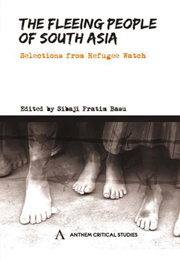Book contents
- Frontmatter
- Contents
- Acronyms and Abbreviations
- Foreword by Ranabir Samaddar
- Preface
- ETHICAL ISSUES
- LAWS
- SOUTH ASIA
- INDIA
- Introduction
- Population Displacement in India: A Critical Overview
- Reporting from Gagan Geer: A Kargil War Refugee Camp
- Barricaded Kashmiri Pandits Letting Go the Right to Return?
- Homeless and Divided in Jammu and Kashmir
- Internal Displacement in North-East India: Challenges Ahead
- The North-East Today: Displacing Identities, Displaced Identities
- Tibetan Refugees in India: Surviving in Exile
- Unrest and Displacement: Rajbanshis in North Bengal
- Adivasis in Coal Mining
- GENDER
- INTERVIEW/CORRESPONDENCE
- REPRESENTATIONS
- Index
Homeless and Divided in Jammu and Kashmir
from INDIA
Published online by Cambridge University Press: 05 March 2012
- Frontmatter
- Contents
- Acronyms and Abbreviations
- Foreword by Ranabir Samaddar
- Preface
- ETHICAL ISSUES
- LAWS
- SOUTH ASIA
- INDIA
- Introduction
- Population Displacement in India: A Critical Overview
- Reporting from Gagan Geer: A Kargil War Refugee Camp
- Barricaded Kashmiri Pandits Letting Go the Right to Return?
- Homeless and Divided in Jammu and Kashmir
- Internal Displacement in North-East India: Challenges Ahead
- The North-East Today: Displacing Identities, Displaced Identities
- Tibetan Refugees in India: Surviving in Exile
- Unrest and Displacement: Rajbanshis in North Bengal
- Adivasis in Coal Mining
- GENDER
- INTERVIEW/CORRESPONDENCE
- REPRESENTATIONS
- Index
Summary
When it comes to the internally displaced in Jammu and Kashmir, the state's response in the face of a lack of policy to deal with the problems of the displaced community is much like a leaf from George Orwell's Animal Farm. All are equal but some are more equal than others. The differential treatment that the different kinds of displaced get in terms of relief and attention eventually prevents them from finding a common cause with each other or talking about a common ground. There are hierarchies and hierarchies within hierarchies among different groups of people displaced at different times, ever since the Kashmir dispute began in 1947. In the absence of any state policy or international law on the internally displaced, there are different ways of treating the displaced, as per the whims or the political needs, or often the greed, of those in power. While this has benefited some politicians, it has kept the internally displaced in Jammu and Kashmir, roughly numbering 7 to 8 lakhs, divided. […]
There are several kinds of people displaced due to the conflict – those uprooted by the partition of Jammu and Kashmir in 1947–8, and thereafter by some territorial alterations in subsequent wars in 1965 and 1971, those who have been forced to flee, in the last couple of decades, from the Indian side of Kashmir to the Pakistani side, those displaced due to recent India–Pakistan border confrontation after the Kargil War and subsequently Operation Parakaram, those displaced due to violence in militancy hit areas and those displaced from one militancy infested area to a slightly lesser one.
- Type
- Chapter
- Information
- The Fleeing People of South AsiaSelections from Refugee Watch, pp. 244 - 248Publisher: Anthem PressPrint publication year: 2009

